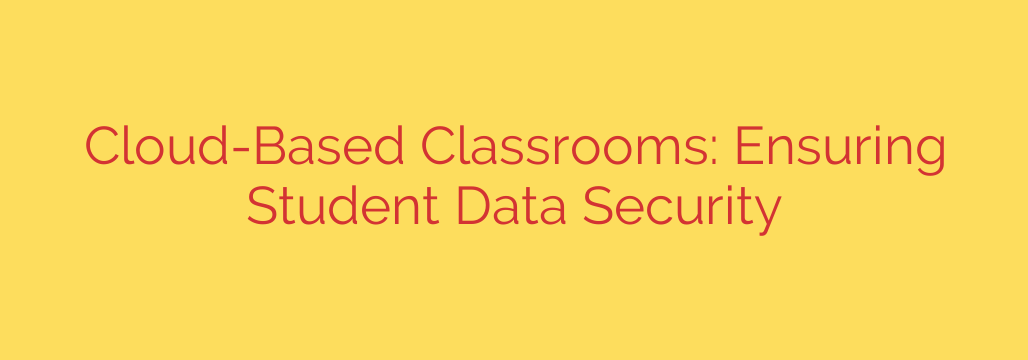
The Digital Backpack: Securing Student Data in the Modern Cloud Classroom
The landscape of education has transformed. Gone are the days of purely physical textbooks and chalkboards; today’s classrooms are dynamic digital ecosystems powered by the cloud. From collaborative documents and online learning platforms to interactive apps and assessment tools, cloud technology has unlocked incredible opportunities for learning. However, this digital shift brings a critical responsibility: protecting sensitive student data.
As schools and educators embrace these powerful tools, they also become guardians of a vast amount of personal information. This data, if mishandled, can expose students to significant risks. Ensuring robust security isn’t just an IT issue—it’s a fundamental aspect of student safety and institutional integrity.
Understanding the Risks in a Cloud-First Environment
The convenience of cloud-based EdTech can sometimes mask the underlying security challenges. Every new application or platform adopted by a school district creates a new potential vulnerability. It’s crucial for administrators, educators, and parents to be aware of the primary threats.
- Data Breaches and Cyberattacks: Schools are increasingly becoming targets for cybercriminals. Stolen student data—which can include names, birthdates, addresses, and even academic or health records—is valuable on the dark web and can be used for identity theft.
- Third-Party Vendor Vulnerabilities: Many schools rely on a complex web of third-party EdTech vendors. If a single one of these vendors has weak security protocols, it can create a backdoor for attackers to access the data of every school that uses their service.
- Compliance Violations: Educational institutions must adhere to strict data privacy regulations, such as the Family Educational Rights and Privacy Act (FERPA) in the United States. A data breach or improper handling of student information can lead to severe legal and financial penalties.
- Accidental Exposure: Not all threats are malicious. Data can be exposed accidentally through misconfigured cloud settings, a lack of proper access controls, or simple human error.
A Blueprint for Stronger Student Data Security
Protecting student information requires a proactive and multi-layered approach. It’s a shared responsibility that involves everyone from the district superintendent to the classroom teacher. Here are essential best practices every educational institution should implement.
1. Establish a Clear Data Governance Policy
You cannot protect what you don’t define. Schools need a comprehensive policy that outlines exactly what data is collected, why it’s collected, where it’s stored, and who has access to it. This policy should be the foundation of your security strategy, ensuring that data collection is limited to only what is necessary for educational purposes.
2. Thoroughly Vet All EdTech Vendors
Before adopting any new app or platform, conduct rigorous due diligence. Don’t just focus on the features; scrutinize the vendor’s security and privacy policies. Ask critical questions:
- Where is our data stored?
- Is the data encrypted both in transit and at rest?
- Do you comply with FERPA and other relevant regulations?
- What is your data breach notification plan?
- Do you sell or share student data with advertisers or other third parties?
A vendor’s reluctance to provide clear answers to these questions is a major red flag.
3. Implement Strong Access Controls
The “Principle of Least Privilege” is a core security concept that is vital for schools. This means that individuals should only have access to the specific data and systems they absolutely need to perform their jobs. A teacher, for example, should have access to their students’ grades but not the financial records of the entire district. Implementing role-based access controls significantly reduces the risk of both internal and external threats.
4. Prioritize Data Encryption
Encryption is one of the most effective technical safeguards. It essentially scrambles data, making it unreadable to anyone without the proper decryption key. All sensitive student data must be encrypted, both when it’s being transmitted over a network (“in transit”) and when it’s stored on a server or hard drive (“at rest”). This ensures that even if a system is breached, the stolen data remains useless to the attackers.
5. Conduct Regular Security Training
Technology is only one part of the solution. The human element is often the weakest link in the security chain. Regular, mandatory security awareness training for all staff—including teachers, administrators, and IT personnel—is non-negotiable. This training should cover topics like identifying phishing emails, creating strong passwords, and understanding the school’s data security policies.
The Role of Parents and Students in Digital Safety
Security is a team effort. Parents and students also play a crucial part in protecting personal information.
- For Parents: Stay informed about the technology your child is using at school. Don’t hesitate to ask the school administration about their data privacy policies and the vendors they use. Review the privacy settings on any school-related apps and have open conversations with your child about responsible online behavior and the importance of not oversharing personal information.
- For Students: Educators should integrate digital citizenship into their curriculum. This includes teaching students about the importance of strong and unique passwords, recognizing suspicious online activity, and understanding their own digital footprint.
Ultimately, securing student data in our cloud-based classrooms is an ongoing commitment. By developing strong policies, vetting technology partners carefully, and fostering a culture of security awareness, we can embrace the benefits of modern educational tools while upholding our duty to protect the students we serve.
Source: https://collabnix.com/student-data-security-an-essential-in-cloud-based-classrooms/








